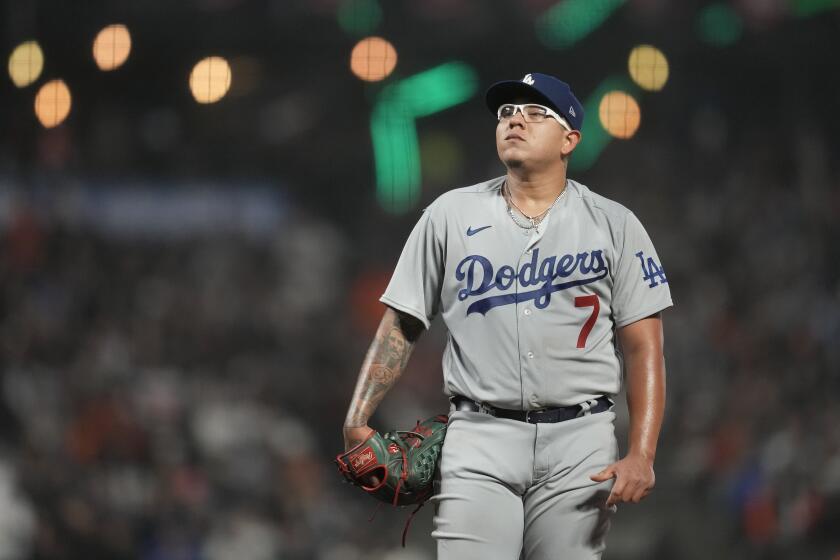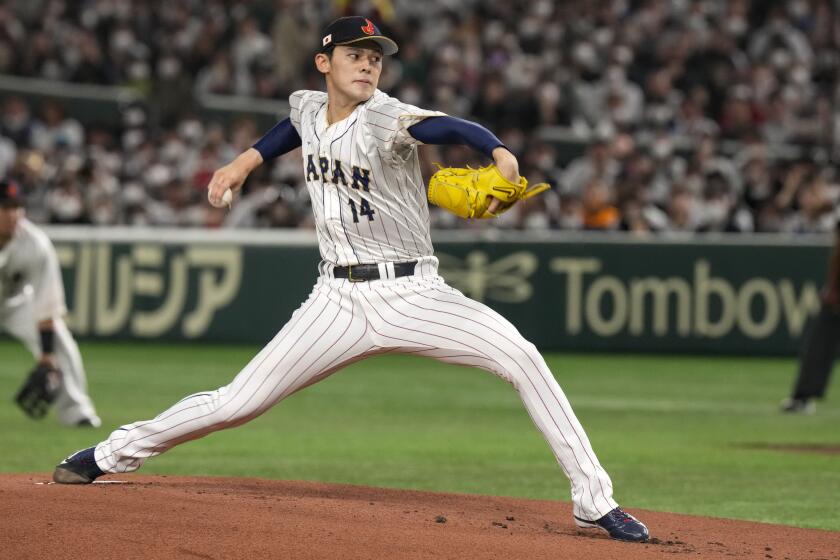Opening to Mixed Reviews
The first day of the new season at Dodger Stadium was only partly about baseball.
For a record crowd that came to Chavez Ravine on Tuesday, the home opener against the rival San Francisco Giants also offered a chance to see firsthand what $20 million in off-season renovations had done to the venerable ballpark.
So even as the Dodgers came from behind with a dramatic 9-8 victory in the bottom of the ninth inning, fans were keeping score in a way that had nothing to do with hits and runs.
From his cushioned seat behind the home dugout -- part of a new, high-priced section built over what used to be foul territory -- Craig Olivier could not have been more pleased.
âThe angles are good,â the 45-year-old bank executive from Santa Clarita said between bites of a hot dog. âThese seats are fabulous.â
But that new section blocked the view for some people sitting behind it, in what used to be a prime location. And 20 or so rows higher, longtime season-ticket holders found that a new âribbonâ video board hung down from an upper deck just far enough to keep them from seeing the scoreboard in the outfield.
âItâs awful,â said Pam Amici, of Long Beach. âWeâve had these seats for 31 years.â
The modifications to Dodger Stadium -- the most extensive remodeling in its 43-year history -- had been a hot topic of discussion all winter. The ballpark ranks as something of a cultural institution in Los Angeles, not to be casually trifled with.
It did not help that the changes were ordered by Frank McCourt, the Boston developer who purchased the team before last season and remains controversial, viewed with suspicion by many local fans.
âWhen I first heard about what they were doing [to the stadium], I was like, why mess with it?â said Aaron Squires, 37, of Burbank. âI wanted to see what it looked like.â
Some of the 55,892 in attendance -- a regular-season record -- noticed a difference even before reaching the ballpark. Season-ticket holders paid higher prices to renew their seats. The cost of parking went up for some.
Inside the gates, the impact of off-season construction was greatest on the field level, the band of seats closest to the diamond.
Fans such as Olivier were thrilled at the chance to sit closer to the action than had ever been possible at Dodger Stadium, those 1,600 new seats built on 10,000 square feet of foul territory down both baselines. Such luxury cost as much as $400 a seat.
Those who could not afford to pay that much -- or simply chose not to -- remained in their original spots. Only now, their front-row seats had become more like 12th-row seats.
Christine Hampton, 36, of Huntington Beach, figured that players could no longer toss balls to her over the dugout. Jim Hayden, 80, of Bakersfield, mused that he used to be close enough for former player and manager Bill Russell to lean over the railing and give him an autograph.
Such was Rich Sielaffâs displeasure that he arrived at the game wearing a T-shirt that juxtaposed McCourtâs name with an obscenity. The team owner, Sielaff said, âhas taken a trust and ruined it. Heâs chopped up the stadium. ... I think heâs an outsider who hasnât been respectful of fans in this city.â
Other fans were more accepting, getting McCourtâs autograph as he walked through field-level seats before the game, and congratulating him afterward.
It figured that in the top of the first inning, the Giants would hit a foul ball that landed a couple of rows over the railing, in what used to be foul ground. The crowd groaned.
Many longtime fans were upset about aesthetics.
The outfield fence, once adorned with images of past Dodger greats, bore corporate logos. The long, thin video board wrapped around the stadium flashed advertisements by the dozens. A delivery company had its name on yellow stripes that ran across the bullpen gates.
âIt looks like a crime scene,â said Matt Hampton, 35, of Simi Valley.
Mike Aldo, 80, of Whittier, grumbled: âIâm an old guy. I like it the old way.â
Such complaints seemed to diminish the farther fans sat above the field. In the upper decks, there were no new seats in front of them, nothing blocking their views. The skeptical Squires, all the way at the top, said: âI understand what theyâre doing because itâs a business. The field still looks great.â
And there were several modifications that met with universal approval. In the loge level, Louie Moreno walked right up to one of the new automated teller machines, no longer having to wait in line to get cash.
Sam Chu of Cerritos liked paying for three hot dogs and a couple of sodas with his credit card, a new convenience.
David Winfrey of Culver City didnât even notice that a new company had taken over the concession stands. He said the food tasted the same, the lines no longer or shorter than in seasons past.
At the Sport Management Research Institute in Weston, Fla., a consultant for stadiums and arenas nationwide, Executive Director Kathleen Davis said fans were likely to complain about any sort of changes to traditional ballparks at first.
âThe bottom line is ... will they still come to the games?â Davis said. âThe true test is to look at the numbers later in the season.â
Davis also said that most fans are sophisticated enough to understand that professional teams must generate revenue. Dodger executives have said the new seats and additional advertising would translate into tens of millions of dollars, while pointing out that 80% of the seats cost the same as last year.
âEverything is about money now,â said Bruce Hellebrand, 50, of Newbury Park, wearing a Dodger jersey. âI just hope they will pay for better players.â
And none of it seemed to matter in the bottom of the ninth inning, when the Dodgers came from behind to win on a base hit by outfielder Milton Bradley.
All eyes were fixed on the field. From the new first row all the way up to the $6 seats, the crowd stood and cheered like it was any other season.
Times staff writer Alex Kimball contributed to this report.
More to Read
Are you a true-blue fan?
Get our Dodgers Dugout newsletter for insights, news and much more.
You may occasionally receive promotional content from the Los Angeles Times.











